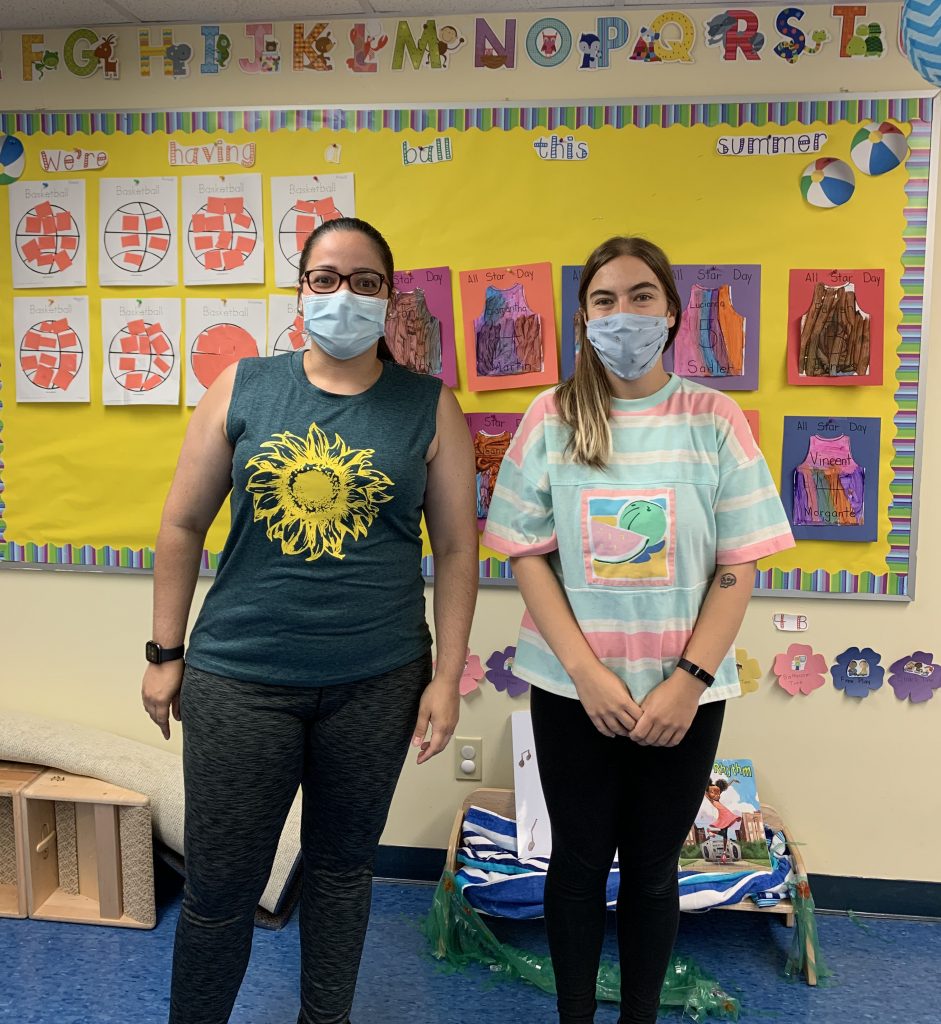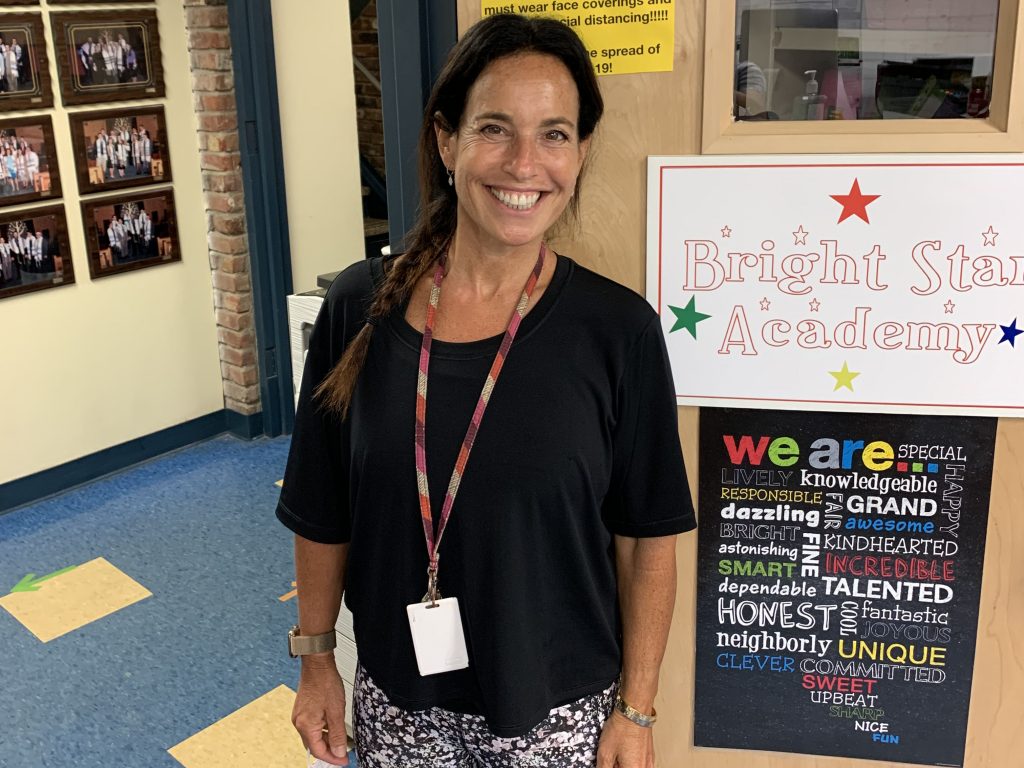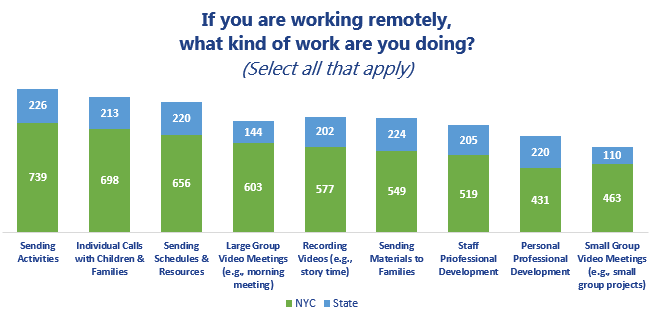As New York State slowly begins to re-open, many early care and education providers are wondering what work will look and feel like when they return to their centers. Teaching, Leading and Caring (TLC) is sharing the perspectives of leaders of programs across the state that have stayed open or reopened. We hope that this helps to light the way forward.
Lori Bader has been the Educational Director of Bright Star Academy for over 20 years. Bright Star serves the Oceanside and surrounding communities in the Long Island region. Bright Star started in the living room in a private house in 1981. Shortly after more space was needed and Bright Star moved into a neighborhood church in 1984. At this time Bright Star had three classrooms, which they outgrew within a few years. In 1990 the program moved into a new building. They then had 5 classrooms and an indoor and outdoor play area. In 2013, after Hurricane Sandy Bright Star Academy had to be relocated. They currently participate in QUALITYStarsNY and have 9 classrooms with indoor/outdoor play areas.
Many educators are looking forward to the reopening phase. Can you tell us a little bit about your decision making for closing and then reopening?
On March 20th, we closed our program. During that weekend I couldn’t get in touch with anyone and I had so many questions regarding my program. Because I didn’t receive clear guidance, and I wasn’t sure if child care was considered an essential business we closed our program. During the time when we were closed, guidance was given from the State agencies and I prepared to re-open, writing policies, procedures and action plans.
How did you prepare your staff prior to your reopening on May 18th?
A week before we opened, I brought my staff back for a full week of training to get them ready. I purchased lots of cleaning supplies. A cleaning company came to our program and did a training with my staff in our parking lot. They taught us how to use the cleaning supplies, explained the difference between sanitizing and disinfecting, and walked us through how to use the solutions on different surfaces. This session was very informative and we allowed for our staff to ask as many questions as needed so they can feel prepared to do this work in the classroom. I also had our custodians participate in a special training with the company as well.
I prepared an action plan with new health policy and procedures. I worked with my health care consultant and the Child Care Council of Nassau prior to sharing the new updates with my team. During our training week I held a zoom session with all staff and presented a PowerPoint presentation with the action plan, new health care procedures, and allowed time for an open dialogue and Q & A session.
Finally, I worked with my team to develop strategies for maintaining physical distancing in the classroom. Each classroom came up with their own approach that made sense for their classroom space, age group, and comfort level of teachers.

Do you have any advice to share with our leaders regarding your approach to reopening?
I would say make sure you engage staff in the learning process. If you want them to feel safe and accomplished in the program, you need invite them to help create new procedures that work in their classrooms. Since we reopened gradually beginning with three days per week for 3 hour increments, it allowed staff to learn how to work in a new context. You can provide as much training, but once teachers actually can see how this works in the classroom by starting off slow and small worked really well. I have to say that I equate the success of our reopening to my staff! They all have been amazing partners in making this work. The families have also been amazing. They trust us and have been very supportive during this time.
Now that you have been open for 6 weeks, can you tell us what is was like when you first reopened? How are things working for you?
The first week my staff were on edge. There were so many things we didn’t know and we were all trying our best to make it work. Each day was sort of a trial and error process. I remember something that was shared during the Leadership Initiative Networking Meetings, “slow and steady wins the race.” Well I took that advice and we started off slow.
For the first month, we only opened three days a week (Tuesday, Wednesday, and Thursday) for 3-hour sessions with staggered arrival times. Children were not napping or eating lunch with us. Each day another child returned back to school. During our first week I started off with 10 children and by the end of the week we had 23 children.
As children arrived each morning, they would get dropped off in our lobby and I would do a temperature check and ask them “Are you ready for a great day?” Okay come on in.
The modified schedule was key to our success thus far. This process allowed our staff to learn how to do things and try out the strategies without feeling overwhelmed. For example, staff wondered, “what if two people have to go to the bathroom at the same time?” We developed so many strategies such as putting tape outside of the door to indicate special requirements and directions. One of the assistant teachers has become the playground “disinfectant monitor.” After each class leaves the playground, the teacher sprays the equipment with the disinfectant spray and leaves it on for 10 minutes before the next class uses the equipment. I have to say, the children made a seamless transition. Now as we enter our summer program starting on June 15th, I have over 70 children now! We are ready to implement our new changes and will be providing care for all children five days a week for a full day.

Can you share some of the strategies you have implemented to ensure physical distancing?
Well you can’t tell a toddler or two-year-old to stay away from one another! So it is hard to enforce physical distancing. We developed a few strategies that have helped us maintain distance in the classroom while also making sure children understand the process too.
- We ask all families to bring in clean towels daily. We use towels on carpets, for outdoor story time as a way to demonstrate personal space and distance.
- Our hallways have tape on the floors with arrows showing direction and spatial distance
- Some classrooms have introduced the concept and language of butterfly wings or helicopter arms to demonstrate appropriate distance.
- Other classrooms printed children’s pictures and placed them on the floor with the appropriate space for children to line up on their picture or helicopters on the floor to stand on.
What were some of the obstacles that you experienced? Can you also share what have been your source of support and strength during this time?
My program has been through many crises in the past. We lived through Hurricane Sandy. Our entire school was ruined and we had to rebuild the program. During Sandy, our community and staff were key to helping us rebuild. Parents gave us donations of books and materials. We thought Sandy was the worst, but COVID-19 is worse. Our team is extremely resilient because we have gone through a crisis and know how to preserve and come out on top.
Being a child care director of a small private program is very isolating, especially during a crisis. Having the support and space to learn from others during this time through the Leadership Initiative’s Networking Meetings has been a nice exchange of ideas and feeling that you are not alone. My QUALITYStars specialist, Stefanie Straker, has also been instrumental to our work. The amount of support I have received from QUALITYstarsNY has made all of the difference. We had a difficult time getting supplies but QUALITYstarsNY came by and gave us what we needed. The Child Care Council provided some materials for our program and OCFS has also been extremely informative in guiding our decision making processes.
Can you tell us how you are supporting playful learning during center time?
This is definitely something that takes some creativity to make happen. Currently, we have all of our shelves turned around with butcher paper covering the open access. In order to create a space for children to play with materials we also discussed several strategies to ensure the health and safety of the children. One classroom decided to create individualized bins for each child. Another classroom had a Ziploc baggie labeled for each child. Every day the toys would get disinfected. We did our best to only allow toys that could be disinfected to be placed in the bins or Ziploc bag.
Dr. Cristina Medellin-Paz is the Institute’s Career Development Coordinator for Long Island.



